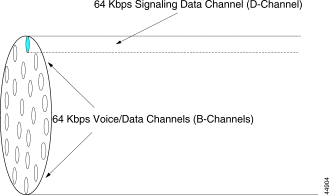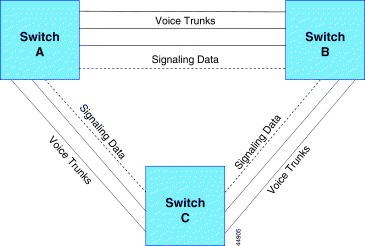|
|

Everything in the telecommunications network is based on signaling—call setup, connection, teardown, and billing. The two forms of signaling used by the network are:
In order to route telephone traffic through the Public Switched Telephone Network (PSTN), it is necessary to communicate with the switches that make up the PSTN. Signaling is a means for transferring network-related information between switching nodes, and also between the end office switches and their subscribers. (See Figure 1-1.)
Signaling is used to do the following:

When used for in-band signaling:
The principal advantage of CAS is that it is inexpensive to implement and can be used on any transmission medium.
However, CAS has the following disadvantages:
CCS employs a separate, dedicated path for signaling. (See Figure 1-2.) Voice trunks are used only when a connection is established, not before. Call setup time is quicker because resources are more efficiently used. CCS is the technology that makes ISDN and SS7 possible.

Integrated Services Digital Network— Primary Rate Interface (ISDN-PRI) divides digital transport services into bearer channels (B-channels) for voice and data transmission and data channels (D-channels) for signaling data. (See Figure 1-3.)
In North America T1-PRI employs 24 channels (23B+1D at 64 Kbps per PCM channel) with an aggregate bandwidth of 1.536 Mbps. In Europe E1-PRI employs 32 channels (30B+2D at 64 Kbps per PCM channel) with an aggregate bandwidth of 2.048 Mbps.
ISDN-PRI offers the following advantages:

While similar to ISDN-PRI, Signaling System Number Seven (SS7) uses different messaging for call setup and teardown. SS7 lets any SS7-enabled node to talk to any other, regardless of whether they have direct trunk connections between them.
With this type of signaling, the signaling link directly parallels associated voice trunks. Thus, dedicated links must be provisioned between every interconnected switch. (See Figure 1-4.)

With this type of signaling, voice/data and signaling are carried on separate, logical paths. Multiple nodes in the signaling path to the final destination can causes delays. Although used in the SS7 network, it is not preferred. (See Figure 1-5.)
This type of signaling employs a minimal number of nodes, thus minimizing delays. Quasi-associated signaling is the preferred signaling mode for SS7. (See Figure 1-6.)

This was the first use of packet switching in the PSTN. SS6 packets consisted of 12 signal units of 28 bits each placed into a data block.
The call flow of an 800 number is as follows:
When 800 number lookups via SS7 proved successful, the network was expanded to include the ability to do call setup, teardown, and other services. Call setup/teardown is done using the ISDN User Part (ISUP) protocol. Database lookup uses the Transactional Capabilities Application Part (TCAP) protocol.
SS7 is deployed on two distinct levels or planes:
Bellcore is an extension of the ANSI protocol and ensures the ability to interoperate with Bell Operating Company (BOC) networks.
Gateways convert national versions of SS7 to ITU-TS versions so that the networks of all nations can interoperate with each other.
Seamless roving in cellular networks uses SS7 to share subscriber information from Home Location Registers (HLRs) so users do not have to register their cell phones with other providers when they travel. All cellular providers can access each others databases via SS7, enabling their subscribers to roam seamlessly from one network to another, while still allowing the home network to track and bill for all calls.
1. Name the two types of signaling used in the PSTN.
2. Which signaling type categorizes SS7?
3. How is ISDN-PRI similar to SS7?
4. What is an advantage of common channel signaling?
5. Name the three modes of common channel signaling.
6. Which mode is preferred for SS7? Why?
7. From which network was SS7 derived?
8. How fast are SS7 links?
9. What is the ISUP protocol used for?
10. What is the TCAP protocol used for?
11. What are the two versions of SS7?
12. What version of SS7 is used in the United States?
13. What function does an SS7 gateway perform?
14. How do cellular networks utilize SS7?
15. What is the AIN?
![]()
![]()
![]()
![]()
![]()
![]()
![]()
![]()
Posted: Sat Sep 28 13:44:40 PDT 2002
All contents are Copyright © 1992--2002 Cisco Systems, Inc. All rights reserved.
Important Notices and Privacy Statement.